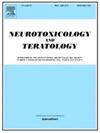Pregnancy protects nervous tissues against the neurotoxicity of intrathecal bupivacaine in rabbits
IF 2.8
3区 医学
Q3 NEUROSCIENCES
引用次数: 0
Abstract
Background
Local anesthetics have been associated with spinal neurotoxicity, including the risk of persistent neurological injury. Pregnancy is known to increase the sensitivity of nervous tissue to local anesthetics, potentially elevating the risk of neurological deficits in obstetric patients following spinal block. This study aimed to investigate the effects of pregnancy on the neurotoxicity of intrathecal bupivacaine.
Methods
Pregnant and non-pregnant rabbits were administered three injections of either 0.375 % or 0.75 % bupivacaine, or normal saline, at 48-h intervals (average volume: 200 μl). Seven days after the first injection, electron microscopic scores (EMS), spinal neuronal apoptotic rates, intracellular Ca2+ concentrations, and mitochondrial membrane potential were evaluated.
Results
The EMS indicated more severe neurotoxicity in non-pregnant rabbits compared to pregnant rabbits in the bupivacaine-treated groups (median [Q1-Q3]: 23 [21–26] vs. 21 [18.5–24], P = 0.045). Pregnant rabbits exhibited significantly lower apoptosis rates and intracellular Ca2+ concentrations, along with a higher mitochondrial membrane potential compared to their non-pregnant counterparts (0.99 % ± 1.33 % vs. 2.03 % ± 2.09 %, P < 0.01; 240 ± 104 vs. 257 ± 112, P < 0.01; 84.1 % ± 6.1 % vs. 69.9 % ± 15.4 %, P < 0.01).
Conclusion
These findings indicated that pregnancy protects nervous tissue against the toxicity of intrathecal bupivacaine.
Conclusion: These findings suggest that pregnancy confers a protective effect on nervous tissue against the neurotoxicity induced by intrathecal bupivacaine.
妊娠保护兔神经组织免受鞘内布比卡因的神经毒性。
背景:局麻药与脊髓神经毒性有关,包括持续性神经损伤的风险。已知妊娠会增加神经组织对局麻药的敏感性,可能会增加脊髓阻滞后产科患者神经功能缺损的风险。本研究旨在探讨妊娠对鞘内布比卡因神经毒性的影响。方法:给怀孕和未怀孕家兔注射0.375 %或0.75 %布比卡因或生理盐水,每隔48 h注射3次(平均体积:200 μl)。第一次注射后7天,观察电镜评分(EMS)、脊髓神经元凋亡率、细胞内Ca2+浓度和线粒体膜电位。结果:EMS显示,与布比卡因治疗组的妊娠兔相比,未妊娠兔的神经毒性更严重(中位数[Q1-Q3]: 23[21-26]比21 [18.5-24],P = 0.045)。怀孕的兔子表现出显著降低细胞凋亡率和细胞内钙离子浓度,以及更高的线粒体膜电位比没有怀孕同行(0.99 % ±1.33 % 2.03 vs % ±2.09 %,P 结论:这些研究结果表明,孕期保护神经组织对鞘内bupivacaine的毒性。结论:妊娠对神经组织对鞘内布比卡因引起的神经毒性有保护作用。
本文章由计算机程序翻译,如有差异,请以英文原文为准。
求助全文
约1分钟内获得全文
求助全文
来源期刊
CiteScore
5.60
自引率
10.30%
发文量
48
审稿时长
58 days
期刊介绍:
Neurotoxicology and Teratology provides a forum for publishing new information regarding the effects of chemical and physical agents on the developing, adult or aging nervous system. In this context, the fields of neurotoxicology and teratology include studies of agent-induced alterations of nervous system function, with a focus on behavioral outcomes and their underlying physiological and neurochemical mechanisms. The Journal publishes original, peer-reviewed Research Reports of experimental, clinical, and epidemiological studies that address the neurotoxicity and/or functional teratology of pesticides, solvents, heavy metals, nanomaterials, organometals, industrial compounds, mixtures, drugs of abuse, pharmaceuticals, animal and plant toxins, atmospheric reaction products, and physical agents such as radiation and noise. These reports include traditional mammalian neurotoxicology experiments, human studies, studies using non-mammalian animal models, and mechanistic studies in vivo or in vitro. Special Issues, Reviews, Commentaries, Meeting Reports, and Symposium Papers provide timely updates on areas that have reached a critical point of synthesis, on aspects of a scientific field undergoing rapid change, or on areas that present special methodological or interpretive problems. Theoretical Articles address concepts and potential mechanisms underlying actions of agents of interest in the nervous system. The Journal also publishes Brief Communications that concisely describe a new method, technique, apparatus, or experimental result.

 求助内容:
求助内容: 应助结果提醒方式:
应助结果提醒方式:


